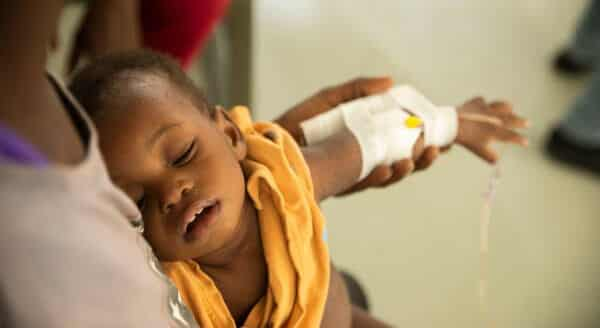As the country approaches the peak of the rainy season, the Nigeria Centre for Disease Control and Prevention (NCDC) has urged Nigerians to avoid open defecation, indiscriminate refuse dumping, ensure proper disposal of waste, and frequent clearing of sewage.
NCDC also advised Nigerians to practice good personal hand hygiene by washing their hands frequently with soap under clean running water, and also ensure that water is boiled and stored in a clean and covered container before drinking.
Meanwhile, 1,307 suspected cases of cholera have been reported across 30 states and 98 Local Government Areas (LGAs), with 34 associated deaths, as of epidemiological week 16 ending April 20, 2025.
This represents a case fatality rate (CFR) of 2.6%, which is well above our target of less than 1%
Cholera is a food and waterborne disease caused by the ingestion of the organism, Vibrio Cholerae, in contaminated water and food. Water is usually contaminated by the faeces of infected individuals. Contamination of drinking water can occur at the source, during transportation, or during storage at home. Food may be contaminated by soiled hands, either during preparation or while eating.
Briefing journalists during the National Health Security meeting on Friday in Abuja, Director General of NCDC, Dr. Jide Idris, observed that Cholera remains endemic in Nigeria, particularly in communities with limited access to clean water and sanitation.
Idris noted that Cholera is a highly contagious infection caused by the bacterium Vibrio cholerae and can be fatal without prompt and adequate treatment.
He said, “As we approach the peak of the rainy season, a concerning trend in cholera transmission is emerging. During the presentation of the 2025 Annual Flood Outlook, the Federal Government issued a warning to 30 states and the Federal Capital Territory about imminent flood risks. Notably, this year’s outlook introduced a community-based forecasting approach designed to enhance preparedness and early response efforts across vulnerable regions.”
Making reference to the forecast by the Nigerian Meteorological Agency (NiMet), Idris noted that over 1,200 communities in 176 Local Government Areas (LGAs) have been identified as high-risk flood zones, and an additional 2,187 communities in 293 LGAs are classified as being at moderate risk of flooding.
He stated that this proactive dissemination of localised flood risk data is expected to drive coordinated action at the federal, state, and community levels, ensuring timely interventions that can help prevent waterborne disease outbreaks like cholera. NCDC is actively tracking these occurrences.
Idris said that 134 Local Government Areas classified as hotspots have been prioritised for multisectoral intervention, including potential RRT deployment, while 36 states and the Federal Capital Territory (FCT) are currently being assessed for readiness to cholera outbreaks.
He noted that while new cholera cases remain relatively low, their spread across 30 states amid the rainy season underscores the need for sustained vigilance and calls for intensified multisectoral collaboration, especially in Water, Sanitation, and Hygiene (WASH), to prevent further transmission and reduce mortality.
Idris warned that beverages prepared with contaminated water and sold by street vendors, ice, and even commercial bottled water have been implicated as vehicles of transmission, as well as cooked vegetables and fruits freshened with untreated wastewater.
According to him, people mostly at risk include people of all ages living in places with limited access to clean water, people living in areas with poor sanitation and poor hygiene, people living in slum areas where basic water or sanitation infrastructure is missing, and people living in rural areas who depend on surface water or unsafe piped or borehole well water sources for drinking, among others.
He listed the symptoms of cholera to include acute, profuse, painless watery diarrhoea (characteristic rice water stools) of sudden onset, with or without vomiting, adding that it may be associated with nausea, profuse vomiting, and fever.
Severe cases can lead to death within hours due to dehydration (massive body fluid loss). However, most infected people (about 80%) may only show mild symptoms or have no symptoms at all.
He added that the disease is easily treatable if detected early and urged Health workers to adhere strictly to the infection prevention and control protocols, including the use of personal protective equipment as needed.
The NCDC boss, who also gave updates on Lassa fever and Cerebrospinal Meningitis (CSM), said that the country has reported 4,253 suspected cases, 696 confirmed cases, and 132 deaths, representing a 19.0% Case Fatality Ratio.
He, however, observed that since epidemiology week 12, Nigeria has recorded a steady decline in confirmed Lassa fever cases from 41 cases down to 10 in epidemiological week 16 (ending April 20, 2025).
Idris noted that both the number of deaths and the case fatality rate (CFR) have also decreased, with only three deaths reported. Cumulatively, as of epidemiological week 16,
He said, “These improvements reflect the positive impact of ongoing surveillance, treatment, and community engagement efforts. However, the risk remains high, especially in endemic areas. So, we must intensify our efforts.”
On the CSM Outbreak Situation, Idris said recent epidemiological data show a steady decline in new cases and fatalities over the past three weeks, signalling that control measures are beginning to have an impact.
He observed that Surveillance, treatment, and vaccination strategies are being dynamically adapted to emerging data, with a strong focus on community trust and early care seeking, adding that while the outbreak remains serious, national and sub-national coordination, improved preparedness, and vaccination efforts are turning the tide.






